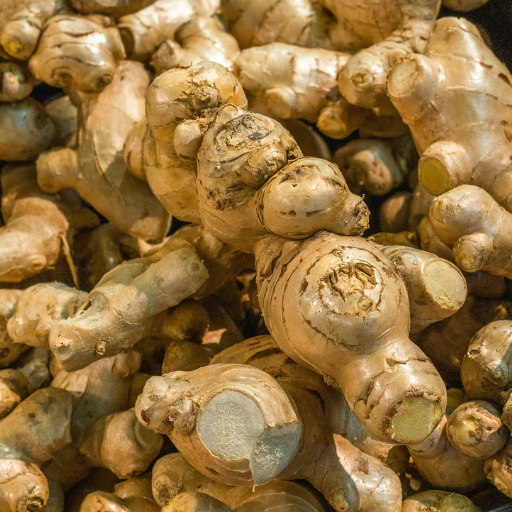Ginger: Why It's a Staple in Every Kitchen and Medicine Cabinet
What are the health Benefits of Ginger?

Ginger is one of the widely and most commonly consumed dietary condiment in the world. It is used in different forms, including fresh, dried, pickled, preserved, crystallized, candid and powdered or ground. The flavour is somewhat peppery or slightly sweet with a strong and spicy aroma. Ginger harvested at 8-9 months has a tough skin and must be removed before eating and the root is more pungent and is used dried or pulverized into ground ginger. This is the form mostly found in spice rack and used in cookies, cakes and curry mixes. It provides a range of health benefits that you can enjoy in many forms. Ginger belongs to the family of turmeric and cardamom. It is widely used as a spice for enhancing flavour and a folk medicine.
Health Benefits Of Ginger
Ginger helps to relieve digestive issues, Relieves tooth aches, Fights colds and flu, Anti-inflammatory, Promotes detoxification, Improves blood circulation, Lowers blood pressure, Relieves menstrual cramps, Helps to protect against cancer, Speeds up metabolism, Can help regulate blood sugar and fight obesity, Helps treat nausea and morning sickness, Fights fungal infection, Protects against stomach ulcer, Prevents cardiovascular disease, Improves brain function, Improves healthier skin, Aids weight loss, Reduces pain, Improves immunity, Aids better digestion, Prevents against disease, Lowers cholesterol, Keeps your mouth healthy, and Fights germs.
Brief History Of Ginger
The first written record of ginger comes from the Analects, written by the Disciples of Confucius in China during the Warring States period (475–221 BCE.) In it, Confucius was said to eat ginger with every meal. In 406, the monk Faxian wrote that ginger was grown in pots and carried on Chinese ships to prevent scurvy. During the Song Dynasty (960–1279), ginger was being imported into China from southern countries.
Ginger was introduced to the Mediterranean by the Arabs, and described by writers like Dioscorides (40–90) and Pliny the Elder. In 150, Ptolemy noted that ginger was produced in Ceylon (Sri Lanka). Ginger — along with its relative, galangal — was imported into the Roman Empire as part of very expensive herbal remedies that only the wealthy could afford, e.g. for the kidneys. Aëtius of Amida describes both ginger and galangal as ingredients in his complex herbal prescriptions. Raw and preserved ginger was imported into Europe in increased quantity during the Middle Ages after European tastes shifted favourably towards its culinary properties; during this time, ginger was described in the official pharmacopeias of several countries. In 14th century England, a pound of ginger cost as much as a sheep.
Archaeological evidence of ginger in northwest Europe comes from the wreck of the Danish-Norwegian flagship, Gribshunden. The ship sank off the southern coast of Sweden in the summer of 1495 while conveying King Hans to a summit with the Swedish Council. Among the luxuries carried on the ship were ginger, cloves, saffron, and pepper.
Ginger originated from Maritime Southeast Asia. It is a true cultigen and does not exist in its wild state. The most ancient evidence of its domestication is among the Austronesian peoples where it was among several species of ginger cultivated and exploited since ancient times. They cultivated other gingers including turmeric (Curcuma longa), white turmeric (Curcuma zedoaria), and bitter ginger (Zingier zerumbet). The rhizomes and the leaves were used to flavour food or eaten directly. The leaves were also used to weave mats. Aside from these uses, ginger had religious significance among Austronesians, being used in rituals for healing and for asking protection from spirits. It was also used in the blessing of Austronesian ships.
Ginger was carried with them in their voyages as canoe plants during the Austronesian expansion, starting from around 5,000 BP. They introduced it to the Pacific Islands in prehistory, long before any contact with other civilizations. Reflexes of the Proto-Malayo-Polynesian word *laqia are still found in Austronesian languages all the way to Hawaii. They also presumably introduced it to India along with other Southeast Asian food plants and Austronesian sailing technologies, during early contact by Austronesian sailors with the Dravidian-speaking peoples of Sri Lanka and South India at around 3,500 BP. It was also carried by Austronesian voyagers into Madagascar and the Comoros in the 1st millennium CE.
From India, it was carried by traders into the Middle East and the Mediterranean by around the 1st century CE. It was primarily grown in southern India and the Greater Sunda Islands during the spice trade, along with peppers, cloves, and numerous other spices.
REFERENCES